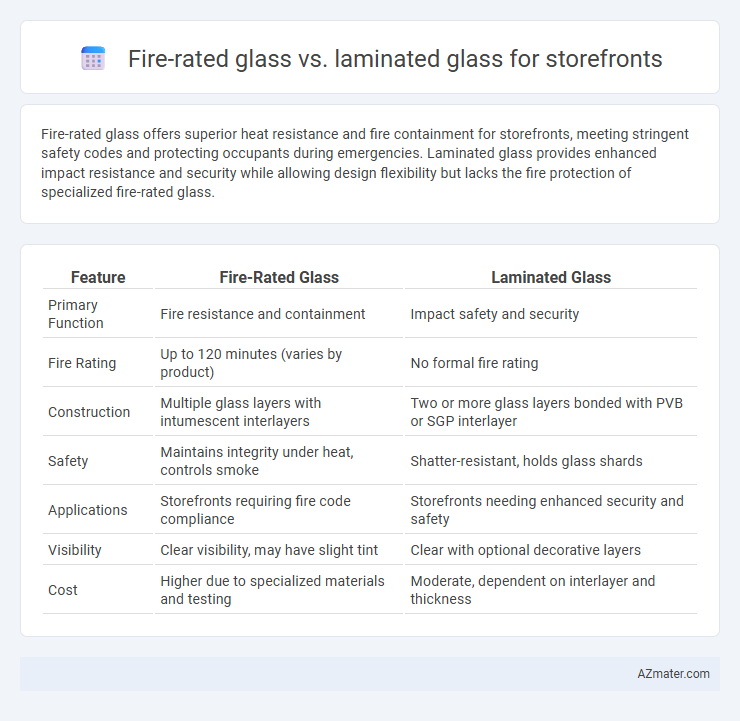Fire-rated glass offers superior heat resistance and fire containment for storefronts, meeting stringent safety codes and protecting occupants during emergencies. Laminated glass provides enhanced impact resistance and security while allowing design flexibility but lacks the fire protection of specialized fire-rated glass.
Table of Comparison
| Feature | Fire-Rated Glass | Laminated Glass |
|---|---|---|
| Primary Function | Fire resistance and containment | Impact safety and security |
| Fire Rating | Up to 120 minutes (varies by product) | No formal fire rating |
| Construction | Multiple glass layers with intumescent interlayers | Two or more glass layers bonded with PVB or SGP interlayer |
| Safety | Maintains integrity under heat, controls smoke | Shatter-resistant, holds glass shards |
| Applications | Storefronts requiring fire code compliance | Storefronts needing enhanced security and safety |
| Visibility | Clear visibility, may have slight tint | Clear with optional decorative layers |
| Cost | Higher due to specialized materials and testing | Moderate, dependent on interlayer and thickness |
Introduction to Fire-Rated and Laminated Glass for Storefronts
Fire-rated glass for storefronts provides enhanced safety by withstanding high temperatures and preventing the spread of flames and smoke during a fire, meeting strict fire-resistance standards such as ASTM E119 or UL 10C. Laminated glass, composed of multiple glass layers bonded with polyvinyl butyral (PVB), offers superior impact resistance and security while also providing UV protection and noise reduction. Both types of glass serve critical but distinct functions in storefront applications, where fire-rated glass prioritizes life safety and fire containment, and laminated glass focuses on durability and occupant protection.
Understanding Fire-Rated Glass: Features and Benefits
Fire-rated glass for storefronts is specifically engineered to withstand high temperatures and prevent the spread of flames and smoke during a fire, offering critical time for safe evacuation. It combines multiple layers of tempered glass and intumescent interlayers that expand under heat to maintain barrier integrity, providing fire resistance ratings from 20 minutes up to 3 hours. The benefits include compliance with fire safety codes, enhanced occupant safety, and minimal compromise on natural light and aesthetic appeal compared to traditional fire-resistant materials.
What Is Laminated Glass? Key Properties for Storefronts
Laminated glass consists of two or more glass layers bonded with an interlayer, offering enhanced safety by holding fragments together upon impact. Key properties for storefronts include high impact resistance, UV protection, sound insulation, and improved security against forced entry. Unlike fire-rated glass, laminated glass does not provide fire resistance but excels in durability and aesthetics for commercial facades.
Comparative Safety Performance: Fire-Rated vs Laminated Glass
Fire-rated glass offers superior protection by resisting high temperatures and preventing flame and smoke penetration during a fire, making it essential for meeting stringent building safety codes. Laminated glass, while providing impact resistance and holding together when broken, does not offer the same level of fire containment or thermal insulation. In storefront applications, fire-rated glass is specifically engineered to maintain structural integrity and visibility under fire exposure, whereas laminated glass primarily enhances forced entry resistance and occupant safety from glass shards.
Building Code Compliance and Regulatory Considerations
Fire-rated glass for storefronts meets stringent building code requirements by providing a certified barrier against fire and smoke, ensuring occupant safety and allowing safe egress during emergencies. Laminated glass, while offering enhanced security and impact resistance, typically does not fulfill fire-resistance ratings required by most building codes for fire separation applications. Regulatory considerations mandate selecting fire-rated glass systems that comply with UL 9, ASTM E119, or equivalent standards to achieve legal acceptance in storefront installations.
Impact Resistance: Which Glass Offers Better Protection?
Fire-rated glass provides superior heat resistance and prevents flame spread, but laminated glass offers enhanced impact resistance due to its interlayer that holds shards together on breakage. Laminated glass absorbs and disperses impact energy, making it more effective in protecting storefronts against forced entry, vandalism, or accidental hits. For storefront applications prioritizing impact resistance and security, laminated glass typically delivers better protection compared to fire-rated glass.
Aesthetic Options and Design Flexibility
Fire-rated glass offers limited aesthetic options due to stringent safety standards, typically featuring clear or wired designs that prioritize functionality over visual appeal. Laminated glass provides greater design flexibility, available in various tints, textures, and patterns that enhance storefront aesthetics without compromising security. Both types support tailored architectural visions, but laminated glass excels in customization and decorative possibilities for modern storefronts.
Cost Comparison: Fire-Rated Glass vs Laminated Glass
Fire-rated glass typically commands a higher initial cost compared to laminated glass due to its specialized materials and rigorous testing standards designed to withstand extreme temperatures and fire exposure. Laminated glass, while generally more affordable, offers enhanced safety by holding shattered pieces together but lacks the fire resistance properties essential for storefronts requiring strict fire codes compliance. Budget allocation for storefront installations must consider not only the upfront pricing but also potential insurance benefits and regulatory requirements favoring fire-rated glass for optimal long-term value.
Installation and Maintenance Requirements
Fire-rated glass installation requires precise framing and sealing with fire-resistant materials to ensure compliance with safety standards, while laminated glass fits standard storefront frames with simpler glazing methods. Maintenance for fire-rated glass involves regular inspections of seals and hardware to maintain fire integrity, whereas laminated glass maintenance primarily focuses on surface cleaning and occasional seal checks. The complexity and cost of maintaining fire-rated glass are higher due to strict fire safety regulations compared to the lower upkeep needs of laminated glass in storefront applications.
Choosing the Right Glass for Your Storefront: Final Recommendations
Fire-rated glass offers superior heat resistance and maintains structural integrity during fire emergencies, making it essential for storefronts requiring compliance with fire safety codes. Laminated glass provides enhanced security and impact resistance, ideal for protecting against break-ins while also reducing noise and UV exposure. For storefronts where fire protection is paramount, fire-rated glass is the optimal choice, while laminated glass best suits locations prioritizing safety and durability against physical threats.

Infographic: Fire-rated glass vs Laminated glass for Storefront
 azmater.com
azmater.com